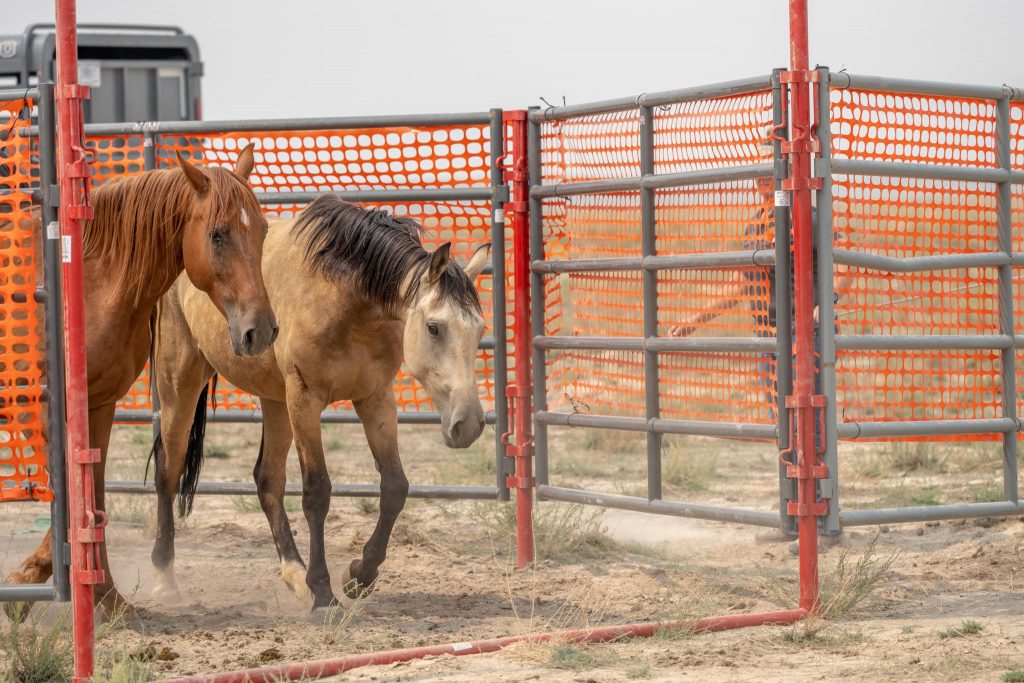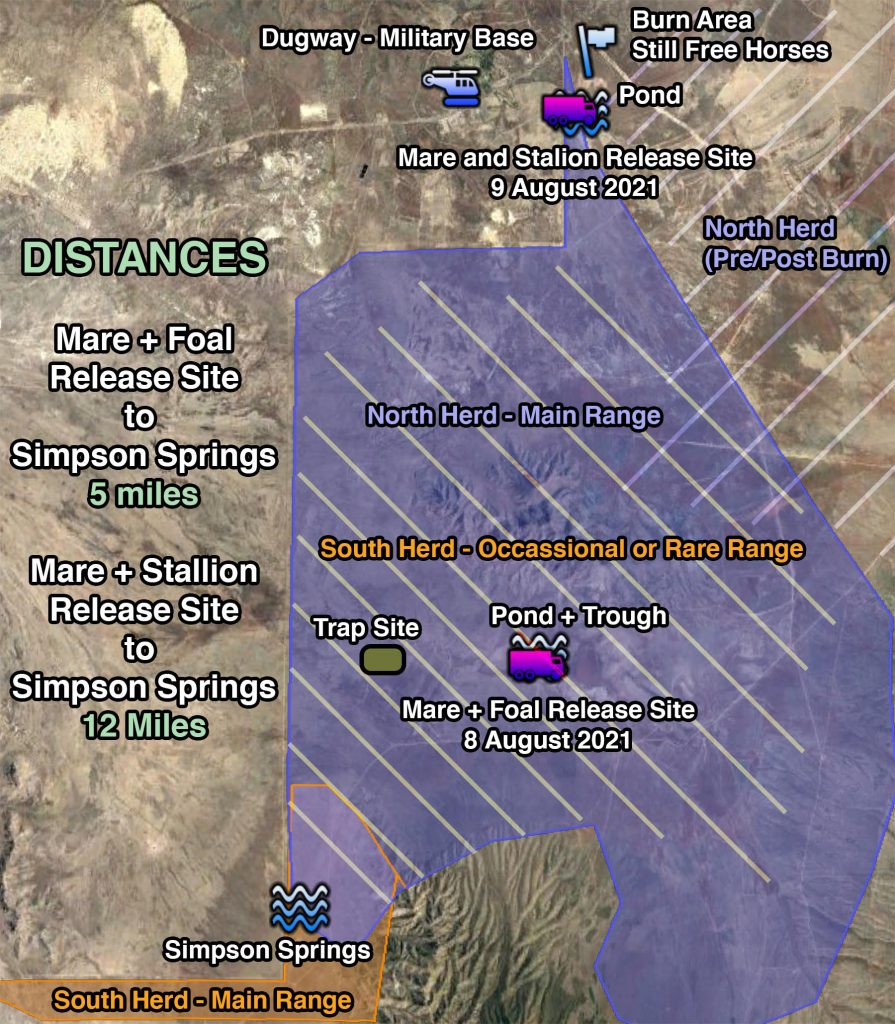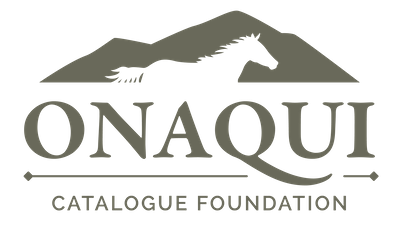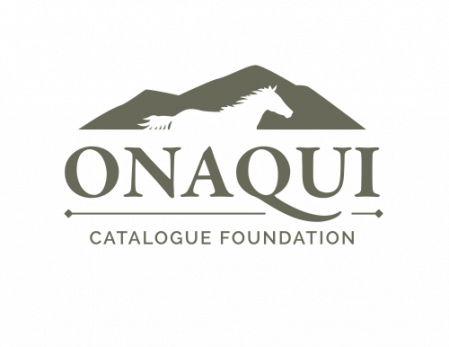About the Roundup

How many horses were gathered and how many were released on the range?
Please see our included map to see where horses were released each day. This map includes water source locations and rough outlines of each main herd’s home ranges. The Bureau of Land Management gathered 436 horses via helicopter (186 stallions, 202 mares, 47 foals) from 14 July 2021 through 20 July 2021. One mare escaped the trap on 15 July 2021 and has been seen wild on the range since, thus 435 horses were gathered in total. On 8 August 2021, 14 mares and foals were released (9 mares and 5 foals), on 9 August 2021, 109 (60 stallions and 49 mares) horses were released, and on 24 August 2021 1 mare was released for a total of 124 horses.

Key Icons and Areas
Blue Flag: Location of the still free horses on the 8th and 9th during each release
Helicopter: Dugway Proving Grounds near the main entrance
Green box: Location of the trap site where horses were gathered from the 14-18th of July.
Orange: A rough outline of the main range of the “south herd”
Blue: A rough outline of the main range of the “north herd”
Diagonal Lines, downsloping to the right: The extended range of the “south” herd where they are occasionally seen.
Diagonal Lines, downsloping to the left: The extended range of the “north” herd. The still free horses were present in this area on release day. This is also the range where the “north” herd occupied prior to the burn and the elevation of the burn fence.
What are all the statistics from the Gather and Post Gather process? (Courtesy of American Wild Horse Campaign).
STATS FROM THE ROUNDUP:
- 435 wild horses captured and removed from the Onaqui HMA between July 14 – 18, 2021
- 1 mare escaped the trap and remains free
- 1 mare was euthanized after sustaining a broken leg in the trap likely after being kicked.
- 124 Onaqui wild horses (59 mares, 60 stallions and 5 foals) were returned to the HMA on August 8 – 9 and August 24.
- 3 mares slated for release died at the BLM’s Sutherland holding facility (one from colic; the others from severe infection).
- 1 mare slated for release was treated with antibiotics at the Sutherland facility and released on 24 August 2021.
- 1 released mare was euthanized hours after her release after being observed to be ill. It is believed that she also suffered from an infection.
- ~210 total horses are currently estimated to be living in the HMA.
- ~300 horses were held in Utah’s BLM Delta Short Term Holding Facility for a BLM Internet auction that was held on December 7-14, 2021.
How were released Onaqui horses selected to be put back on the range?
The Onaqui Catalogue Foundation collaborated with American Wild Horse Campaign to develop criteria to represent the most genetically viable herd to remain after the roundup. Another local non profit, Wild Horses of America, also offered input that the Bureau of Land Management used in the final decision-making process. The following scientific and non-scientific aspects were evaluated to determine the characteristics of a healthy herd:
- Genetic Viability
- Preservation of Family Structures/Bonds
- Maintaining a Natural Herd Structure
- Maintaining a Natural Age Structure
- Maintaining a Natural Gender Structure
Also taken into consideration were these equally important criterion:
- Potential risk of death during post-roundup procedures
- Adoptability during post-roundup
- Maintaining On-Range Darting
Where in the roundup process was Onaqui Catalogue Foundation placed to identify horses to be released?
Onaqui Catalogue Foundation, Wild Horses of America, and the Bureau of Land Management were present at the trap site. Additionally, just after the gather, OCF, WHOA, and the BLM were at the holding facility to further identify horses.
How can one select the most genetically viable herd without genetic testing or genetic information?
This is a first of its kind collaboration with the Bureau of Land Management in hopes of maintaining a genetically viable herd. The Onaqui Catalogue Foundation and American Wild Horse Campaign recognize that this is a significant challenge, thus we conducted as much research as possible with as many resources as available to review how this was approached scientifically in the past. The following scientific attributes, such as birth records, visible genetic abnormalities, age, mare to stallion sex ratio, band ratios, bachelor ratios, observed and documented family structures were analyzed and compared that with an ideal age and sex matrix from other wild equid populations to determine criteria.
Why is the Onaqui Catalogue Foundation working with the Bureau of Land Management?
American Wild Horse Campaign reached out to the Onaqui Catalogue Foundation after conversations with the Bureau of Land Management. The Bureau of Land Management requested that OCF, a local Utah organization, along with Wild Horses of America, another local Utah organization, be present during and after the roundup. We agreed to collaborate in order to provide as many tools and as much information as possible to the Bureau of Land Management and to provide an independent voice in the future of the Onaqui Herd.
Why weren’t other organizations involved in the collaboration?
The choices on the organizations present were made by the Bureau of Land Management.
How long will it take for the horses to settle back to normal after the release on 9 August 2021?
We do not have an exact answer on this. We are receiving reports that horses familiar with one another have banded up and some horses are already being seen in areas they regularly frequented, which is encouraging to hear. This is where citizen science is of so much value—meaning YOU, the public that follow the horses and documents them, play such an important and critical role to the Onaqui Catalogue Foundation mission. We would love for you to share with us your observations on what behaviors you are witnessing, how the horses are banding up, interacting, etc. This data you are contributing helps us present fact-based information. Please upload photos or observations, which you can do directly through our site.
We have heard a mare was euthanized on the range after she was released?
Yes, unfortunately a mare, OQ141sM (Blondie), was euthanized on 09 August 2021. She was found standing with limited movement after the release and showed no interest in water. Those with her witnessed a stallion attacking her and, after four long hours of waiting for improvement, made the difficult decision to contact the Bureau of Land Management. The kind souls who reported the incident stayed with her until her last moments.
Where is the black newborn foal that was spotted at the beginning of the roundup?
On 14 July 2021 a newborn was spotted on the range during the roundup. This information was quickly passed to the Bureau of Land Management, and they alerted the helicopter pilot to avoid the foal and band. However, on 16 July 2021 the mare was observed entering the trap. The foal was not observed with her. We do not know at this time the cause of the foal’s absence but believe him to be deceased. In his photos (available on request), tissue is observed between his legs which is not typically a characteristic of a newborn foal. We consulted a veterinarian and were presented with the possibility of either early testicular descent or inguinal hernia. For domestic horses, neither are typically fatal with treatment. However, a ruptured inguinal hernia has a low prognosis for survival.
We have heard some of the horses are showing signs of diarrhea on 9 August 2021. Is that true?
Yes, diarrhea was observed in some horses. However, at least one horse that had diarrhea was reported on 10 August 2021 to lack any signs of loose stool. Both stress and dietary changes can cause diarrhea in domestic horses and thus we believe the loose stool was a direct result of roundup and release operations and not of any other conditions.
Are the released horses thin? Why do they not look the same as when they were rounded up?
The horses being thin is something that we could expect for wild horses coming out of holding. They have been rounded up, separated, transported several times, and have food at facilities that are not consistent with their wild diet. These are high stress events that can and will impact the horses. We spoke with the BLM to inquire about the food set up. We were advised that the Sutherland facility (facility where released horses were held) has a manger to eat from and it can take the horses time to feel comfortable eating from the manger. The BLM also advised it often takes several weeks for some horses to adapt to these conditions and temporary weight loss isn’t uncommon. Per the BLM’s observations, the horses generally will regain their weight. However, we are collecting images and documenting changes out in the field to see if weights improve or if there is a pattern in which horses have weight loss. If you have images prior to the roundup and after release from similar positions for individual horses please send these to us. Any photos taken over the next few days and weeks will be a good comparison to their weight upon release.
Why were mares and foal pairs released separately from the main group?
This was a decision made by the Bureau of Land Management for the safety of the mares and the foals. One member from each of the following nonprofits, Onaqui Catalogue Foundation, Wild Horses of American, and American Wild Horse Campaign were invited by the BLM as public observers.
Where were the mares and foals released?
Please see our included map above to see where horses were released each day. This map includes water source locations and rough outlines of each main herd’s home ranges. Please note that while we distinguish each herd as “north” and “south” to help us categorize where horses are most likely to be, the wild horses are not limited to these areas and can and do travel outside of these artificial boundaries. Horses are known to travel over 10 miles a day, with some records indicating 20 or even 30 miles is not outside of the norm. In fact, this propensity to travel long distances is believed to be the reason that the Cremello Stallion and his band were gathered in 2019 despite being seen within the HMA only two days before.
Were the mares and foals returned to the range on 8 August 2021 released near water?
Yes. All released horses were released near water. The map above also indicates water sources near the release sites, and the major water source of Simpson Springs. We show only these water sources for simplicity, but there are many more water sources than those shown on the map.
Why weren’t stallions released with the mare and foal pairs on 8 August 2021. Aren’t stallions needed to protect mares and foals?
Mares are capable protectors to their young. While a trusted stallion is a beneficial member of the herd and will protect foals within its herd group, the greatest danger to the foals during release are actually stallions. Stress from roundup and release procedures means that stallion aggression is heightened, and the risk of infanticide (stallions killing foals) is quite high. To our knowledge, most cases of infanticide in wild horse herds are related to horses which have undergone recent captivity or were animals which spent a significant portion of time in captive situations. Releasing mares and foals together allows mares to more easily choose when and how to intermingle with the released horses.
How are the five mare and foal pairs that were released on 8 August 2021 doing now?
The mares and foals remained on the south side of Davis Mountain where they were released as of 15 August 2021. The mare, OQ25upM (Lady), was seen leading all mares and foals towards Davis Mountain after release. This mare has been recorded over the years at both north and south herd watering sites and she knows the range well; her knowledge will be imparted to the mares and foals she is with even if they are less familiar with this particular area. OQ25upM (Lady) and her 2021 foal OQ335bpM (Patches) had found a stallion that they were familiar and friendly with before the end of the day on the 9th. This stallion, OQ102bpS (Charger) had been with OQ25upM (Lady) and her natal band for many years prior to the roundup, though had been recently (since summer 2020) kept at a distance by a black stallion. At this time, our interpretation is that OQ25upM (Lady) remained hidden in the canyons and then intentionally sought him out and we believe OQ102bpS (Charger) may have sought her out as well. Lady and 3 mares and their 3 foals were still with Charger as of yesterday. You can see them in our story highlights. The final mare/foal pair is with a separate band which includes some of the mares released on the 8th.
Why didn’t Onaqui Catalogue Foundation stop the round up?
The Onaqui Catalogue Foundation’s mission is to work in partnership with the public to document, compile, and share information about the Onaqui wild horses in order to deepen understanding and support efforts championing this historically significant herd. Many other local and non local organizations worked day and night to prevent the roundup, and we provided information to all who reached out to us consistent with our mission.

